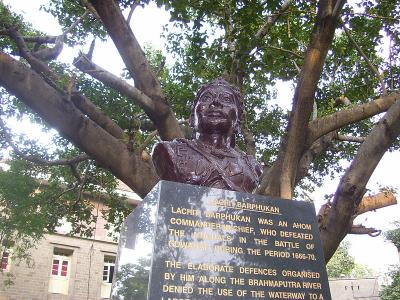|
In this battle the weaker, the Ahom Army defeated the Mughal Army by brilliant uses of the terrain, clever diplomatic negotiations to buy time, guerrilla tactics, psychological warfare, military intelligence and by exploiting the sole weakness of the Mughal forces—its navy.
Lachit Borphukan was born to Momai Tamuli, who later rose to become the first Borbarua (Governor of Upper Assam and Commander-in-Chief of the Ahom army). This enabled Lachit Borphukan to enjoy a comfortable upbringing. His father arranged for his education in humanities, scriptures and military science, and as he grew up he was given positions of responsibility.
Before being appointed as the Supreme Commander of the army, he held various posts of eminence such as Superintendent of the Royal Horses or Ghora Barua, Commander of the strategic Simulgarh Fort and Superintendent of the Royal Household Guards or Dolakasharia Barua assisting the Ahom king. The King Chakradhwaj Singha appointed Lachit as the commander in chief of the Ahom army.
It is recorded that Lachit was made the scarf-bearer (Soladhara Barua) of the Ahom Swargadeo or king, a position equivalent to a Private Secretaryship. This was regarded as the first step in the career of an ambitious diplomat and politician. After he had held various other offices, Lachit was finally appointed as the Commander-in-Chief of the Army under the Ahom King, Chakradhwaj Singha.
The king summoned Lachit to his presence, and in order to test the efficiency of the general-elect, he said to Lachit, "The enemies are in our immediate neighbourhood. How will it be possible to capture their leaders Syed Firoz and Syed Sana? The man whom I am going to appoint as general must be endowed with unusual grit, stamina and depth of judgment."
The King Chakradhwaj Singha presented Lachit a sword with a golden handle called Hengdang, and the customary paraphernalia of distinction, and appointed him Commander-in-Chief of the Ahom Army, which had been raised specifically to drive out the imperial Mughal rulers. Lachit actively participated in raising of the Army and the preparations were completed by the summer of 1667. Lachit at first recovered Guwahati from the Mughals and successfully defended it against the Mughal forces during the Battle of Saraighat. He died about a year later.
Herein it may be mentioned that Assam was the only State in India, which defeated successive attempts at invasion by the Delhi Sultans and the Mughal Emperors. The State survived 17 such invasions.
Lachit's patriotism and devotion to his land is best described by the battle of Saraighat where he even went to the extent of beheading his own uncle for the sake of his land. During the preparations for the battle he ordered an earthen wall for fortification to be constructed within one night and employed his maternal uncle as the supervisor.
Late in the night when Lachit came for inspection, he found that the work was not progressing satisfactorily. When asked for an explanation, his uncle tried to cite tiredness, at which negligence of duty, Lachit became so furious that he beheaded his uncle on the spot, saying "My uncle is not greater than my country." The barrier was completed within that night and the remains of this fortification are still known as "Momai-kota Garh" or "The fortification where the uncle was beheaded."
In spite of his illness, Lachit had himself carried on a boat and with seven boats accompanying him advanced headlong against the Mughal fleet. He shouted, "If you (the soldiers) want to flee, flee. The king has given me a task here and I will do it well. Let the Mughals take me away. You report to the king that his general fought well following his orders." This had an electrifying effect on his soldiers. They rallied behind him and a desperate battle ensued on the Brahmaputra. The Ahoms in their small boats encircled the bigger but less maneuverable Mughal boats. The river got littered with clashing boats and drowning soldiers.
But this great general of the Ahom Army was finally defeated by illness that killed him very soon after the victory at the battle of Saraighat. Lachit Borphukan's last remains lies in rest at the Lachit Maidam built in 1672 by Swargadeo Udayaditya Singha at Hoolungapara 16 km from Jorhat. On 24th November each year Lachit Divas is celebrated in Assam as a State holiday to commemorate the heroism of the great general Lachit Borphukan and the victory of the Assamese Army at the battle of Saraighat.
Lachit Borphukan's bravery and tales of patriotism remained confined to the State of Assam for almost three centuries until the nation was introduced to the great general on November 14, 2000, when his statue was unveiled at the National Defense Academy in Khadakvasla, near Pune in Maharashtra by Lt. Gen. S.K. Sinha (Retd) PVSM, the then Governor of Assam. Sinha is responsible for initiating the process of getting Lachit Borphukan his due from the Nation.
On 24 November each year Lachit Divas (lit. Lachit Day) is celebrated statewide in Assam to commemorate the heroism of Lachit Borphukan and the victory of the Assamese army at the Battle of Saraighat. |








